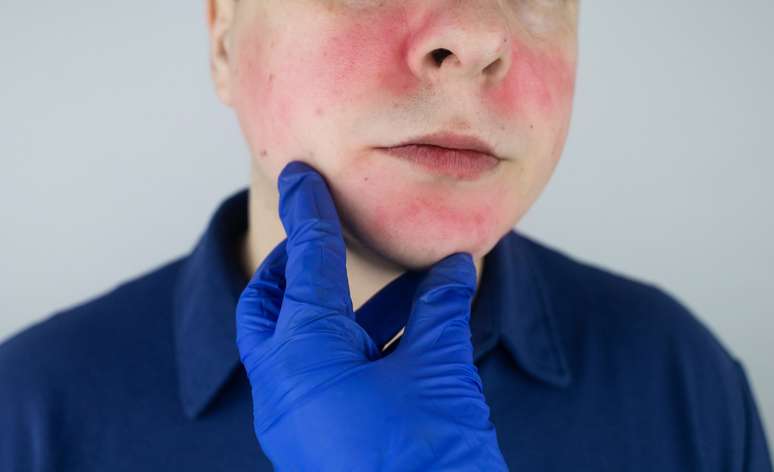Contact dermatitis and rosacea are some possible causes
Does your skin turn red often? Many people suffer from facial flushing whenever they feel embarrassed or after strenuous physical activity. But there are also other types of blemishes that can appear out of nowhere, causing embarrassment. What to do?
It is essential to consult a dermatologist, who will identify the cause of the redness and tell you how to treat it. “It is important to underline that the skin, when it becomes red, can be more irritated, sensitive and susceptible to environmental damage,” explains dermatologist Ana Maria Pellegrini, member of the Brazilian Society of Dermatology and technical manager of the Skin clinic. Below, the expert describes the most common causes of redness on the face:
1. Sun exposure
Even moderate unprotected exposure can change skin tone. This is because, over time, exposure to UV rays can destroy collagen, elastin and other structures. In response, blood vessels dilate to bring blood flow to the area. After multiple unprotected exposures, capillaries can become damaged and have a harder time contracting again, leading to more persistent hot flashes.
The ideal is to always use sunscreen and reapply the product every two hours. If redness and blistering occurs, moisturizers with soothing ingredients, such as aloe vera or calamine, may help.
2. Sudden changes in temperature
Leaving the heat of the street and entering an air-conditioned office, or vice versa, are situations that can cause blushing. Blood vessels adapt to these sudden changes by expanding or contracting to regulate the body’s internal temperature and prevent excessive heating or cooling. In these cases, the skin returns to normal as the body adapts, but keeping it hydrated can be helpful.
3. Food and drinks
Alcohol (or more specifically, a chemical called acetaldehyde) dilates blood vessels. This is why your cheeks may feel a little hot or flushed after having a few drinks. Spicy foods that contain capsaicin (a compound found in peppers) can also trigger an inflammatory response in the skin, as well as contribute to rosacea, another common cause of redness.
4. Rosacea
If you’re in permanent redness mode, you may be dealing with something chronic: an inflammatory disease called rosacea. “Although experts don’t yet know the exact cause, genetic factors, along with environmental factors (such as certain foods, climate, exercise, and sun exposure) can make some people’s skin red, burnt, and prickly. or itchy.” , highlights the dermatologist. Inflamed pimples, pustules, and/or papules that do not respond to typical acne treatments may also appear in people with subtype 2 of the disease.
People with rosacea have very sensitive skin, so it’s essential to see a doctor to find out how to treat symptoms and avoid triggers. Anti-inflammatories recommended by the doctor may be indicated, as well as laser treatment.
5. Sensitivity to certain ingredients
Some active ingredients indicated for skin treatment, such as benzoyl peroxide and salicylic acid, for acne, or acids used in peels, may be too strong for some people. Many of these ingredients can strip your face of its moisture barrier and make it more susceptible to dryness, sensitivity and irritation. In these cases, you can replace products with gentler versions and opt for moisturizers that contain calming ingredients, such as niacinamide, ceramides and aloe vera.
6. Allergic reaction/contact dermatitis
Dermatitis is a broad term that refers to inflammation of the skin. “Contact dermatitis, specifically, occurs when something the skin is exposed to causes simple irritation (in the case of irritant contact dermatitis) or an allergic reaction (allergic contact dermatitis),” explains Ana Maria. If a certain product triggers irritant contact dermatitis, it means it is physically disturbing the skin barrier, causing dryness, redness, itching and flaking.
In the case of allergic dermatitis, the reaction is from the immune system and spots and itching may appear one or two days after exposure. In general, moving away from the causes solves the problem. But if you can’t identify it, you need to consult a dermatologist, who can prescribe allergy tests or prescribe anti-inflammatory creams.
7. Seborrheic dermatitis
It is a form of eczema that causes an itchy (sometimes red) rash and peeling skin. “It’s similar to dandruff, except it can also appear on the face. But unlike the small flakes on the scalp, seborrheic dermatitis also involves inflammation and swelling. The exact mechanisms behind this condition aren’t entirely clear, but some researchers they say it is an inflammatory reaction to the excessive growth of the Malassezia yeast, present in the highly active areas of the sebaceous glands”, explains the doctor.
Outbreaks of seborrheic dermatitis are usually patchy and appear primarily in the center of the forehead (near the scalp), eyebrows, and mouth (or beard) area. The most common treatment is an antifungal cream prescribed by your doctor.
Source: Terra
Ben Stock is a lifestyle journalist and author at Gossipify. He writes about topics such as health, wellness, travel, food and home decor. He provides practical advice and inspiration to improve well-being, keeps readers up to date with latest lifestyle news and trends, known for his engaging writing style, in-depth analysis and unique perspectives.




![Tomorrow belongs to us: What awaits you on October 14, 2025, Tuesday, October 14 [SPOILERS] Tomorrow belongs to us: What awaits you on October 14, 2025, Tuesday, October 14 [SPOILERS]](https://fr.web.img4.acsta.net/img/3a/6b/3a6b6c830f9faa61c326457b86fe9dcd.jpg)

